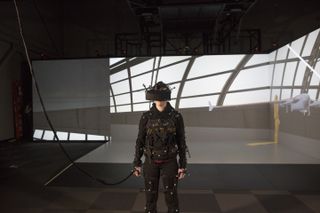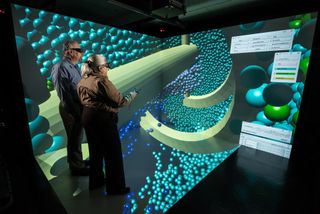For more than three decades, virtual reality (VR) has been working its way into universities and arcades, but it hasn’t enjoyed widespread adoption for commercial applications. However, with significant investments by titans like Facebook and Google, and the recent launch of the wireless Oculus Quest headset, VR is re-emerging as a compelling experiential solution. For AV integrators, VR may seem like a difficult sell, but many analysts argue that now is the time to consider it as powerful addition to their toolkits.
Making the Business Case for VR
Based in Iowa, Mechdyne is a firm with a holistic approach to technology. This established integrator has large-scale VR and visualization acumen, in addition to its own software development arm.
“We’re solutions people,” said Mike Hancock, vice president of Mechdyne. “We have more than 23 years of expertise in AV integration, and we also specialize in visualization, VR at any scale, AR [augmented reality], and software.”
Mechdyne’s software division supports standard AV and business applications, as well as adjacent projects. “We bring the whole solution to the table.” For Hancock, this approach means listening early and asking questions: What are your goals? What’s required for your workflow?

“Our job is to ask a lot of questions to figure out exactly what their business case is for VR or AR, and then provide them with the best roadmap.”
After a rigorous needs analysis, the team will assess if VR would add value. In some cases, VR is not the answer for a client. Sometimes a customer may not be in a position to take full advantage of the immersive technology. In many other cases, “if clients have that open mindset and the leadership support to make any required changes in their work processes, then they become very successful,” said Hancock.
Current VR Ecosystem
A list of well-known AV brands that are also VR providers includes the value-added distributor Stampede, which carries VR solutions, and Barco, which brings commercial VR tools like transportable CAVEs to market. Mechdyne presents the full range of integration possibilities, offering everything from modest VR interaction to high-end installed systems.

Stampede president and CEO Kevin Kelly said that VR can scale up or down depending on the client’s needs: “It can take the form of a short, small element with an HMD, or a very large system that is permanently installed.”
Whether it is a basic solution with a head-mounted display (HMD) or a more advanced CAVE, which allows multiple users to share the VR experience, a pressing challenge for VR is content. “We tend to emphasize that regardless of the hardware, expense, and complexity of the system, it is important to know your application and what software and content will be required for the simulation,” noted Hancock. “Software is probably the thing that most people underestimate.”
VR’s Challenges
In the context of commercial audiovisual technologies, VR is relatively new. For the traditional AV channel and the two-step distribution model—where integrators buy from distributors—it is still considered the early stage for VR adoption.
Besides content and misconceptions about what VR is, an immediate hurdle to wider adoption is the head-mounted display itself. The device is portable and inexpensive, but by its very nature, it is enclosed. It limits interactions with the external world and the built environment, making HMD-driven VR ideal for some applications but impossible for others.
[AR, VR, and MR Enrich Learning Experiences]
Kurt Doornaert, director of Virtual Reality Experience at Barco, believes in the extraordinary potential of VR, but also that more education is necessary to raise its profile. He said that many AV dealers know that Barco “does VR,” but confusion remains. “Some people say, ‘So Barco is into VR? That means you are making headsets?’” Then we have to explain, “No, we do something different with VR projectors and CAVEs.”
Barco designs and manufactures its own high-quality projection screens for VR. It has a new technology called RigiFlex, a flexible screen technology that, once installed, adopts the parameters of a rigid screen. “It is easy to ship and very eco-friendly, and it’s easy to bring into the room where you want to have the VR Powerwall or CAVE installed,” Doornaert said. “That’s another example of how we listen to the market and find solutions.”
Valuable New Tool
With so many technologies available, integrators must choose their tools judiciously. “We may be presenting a proposal to improve workflow in an organization,” said Hancock, “but there may be other things they’re trying to do in the company or in the manufacturing group, so AR/VR is still competing with other new initiatives.”
Inventive tools provide avenues for data capture, and VR is no exception. “There’s more potential data collection, and we now have more accurate systems,” said Hancock. “VR offers full-motion body tracking and a faster ability to get avatars into the software and contact representation so that we can do real-time collaboration. VR collaboration can invite folks who are actively participating in the simulation represented on the screen, and other participants who are experts, to evaluate and make collaborative decisions about what they’re seeing, in real time.”
Vertical Opportunities for VR
The vertical segments that would match well for VR, according to Doornaert, are automotive, oil and gas, education, retail, entertainment, and research centers. Stampede’s Kelly agreed, saying that VR presents exciting new opportunities for manufacturers of custom-built facilities or goods to demonstrate what the facility or product will ultimately look like. Virtual prototyping and data visualization become even more immersive in VR.
For higher education, VR uptake is increasing thanks in part to lighter HMDs and more tech-savvy users. “HMDs have gotten much better, and they are very useful when applied appropriately,” said Hancock. Universities are investing in both modest systems, based on the HMD, and smaller projected systems, moving up to high-end systems. Tech managers can use HMD and large VR systems together or in sequential modes, whereas students can start individual work in HMDs and then share with others in larger systems, or vice versa.
[Classroom Projection and Virtual Reality]
Business owners are leveraging VR to enhance retail operations and promotions. VR can help retailers reimagine and visualize merchandizing options, store layout configurations, and packaging.
“Some retailers tend toward location-based systems to get people’s attention and provide them an interactive experience that might spark interest in the product being promoted,” said Hancock. Walmart has also purchased headsets for employee training.
VR could also be used to sell automobiles that aren’t in stock but could be custom-ordered. “With anything that is highly custom,” Kelly added, “there’s an opportunity.”
Kelly sees VR as a promising tool for architects as well. VR can give users more spatial understanding of a diagram or blueprint. An apartment building or a new construction project can come to life, giving someone the opportunity to quite literally “walk a plan.” VR can help a designer determine where a fixture should be placed or to ascertain the proper doorway placement. “It is an evolution in the way people buy and the way people consume construction services,” Kelly said.
While visualization and spatial computing could save money for decision-makers in architecture or construction planning, “they do tend to be conservative,” said Hancock, “and have not widely adopted VR or AR until more recently.”
AVIXA’s Role in VR?
AVIXA has the opportunity to educate and train the industry, said Kelly, and “act as a catalyst in the marketplace.” Sharing educational resources can help assist new technology owners, whether it’s software or hardware, and attract potential end users.
Stampede is engaged with Oculus, the headset manufacturer, to create innovative solutions for VR. The firm is also bringing to market solutions created by ISVs, or independent software vendors, on the Oculus platform that can be used for commercial purposes.
“Whether you’re an integrator or a valued-added reseller, we strongly encourage both to support the technology, and turn to AVIXA for additional education—about VR and any new technology,” Kelly stated. “If firms are interested in learning more, Stampede will be showing the Oculus VR platform and several vertical market solutions in its booth at InfoComm, which is a very effective way to communicate potential opportunities.”
Future of VR + AV? Think: Teams
As Barco’s Doornaert sees it, people know what VR is, and “now they are looking for solutions where they can work with teams.” This means teams can be in the same room, and multiple people can work together in VR without HMDs. “This is another way Barco supports the industry,” by offering spatially immersive solutions for groups, he added.
“We also have to make sure that in the steps from an HMD to the [VR] system where you use projection, that people are guided in the right way, to reduce the complexity.”
In the 1990s, it was not easy to bring an engineering file into a VR CAVE or to a Powerwall, but today that’s changing. Gaming companies including Epic Games and game development platforms like Unity offer engines that are starting to drive enterprise projects. “It is becoming easier to visualize your content on a kind of display where, as a group, you can evaluate, analyze, and make decisions together,” Doornaert said.













